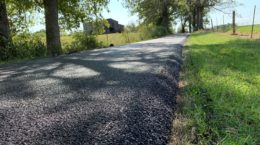When it comes to road building, contractors are constantly trying to do more with fewer virgin materials.
The most common way contractors have learned to do this over the years is through the increased use of recycled/reclaimed asphalt pavement, also known as RAP.
RAP use in asphalt paving will only continue to trend upward in the future, as construction equipment manufacturers find new ways to use higher percentages of RAP without degrading the asphalt pavement’s life expectancy. The move towards ever-increasing rates of RAP is present in both contractors and road infrastructure owners.
Municipalities and other government levels are constantly looking for ways to reduce stress on landfills, which is where RAP plays a significant role. According to the National Asphalt Pavement Association (NAPA), the collection of 97 million tons of RAP were for re-use in 2019, which equates to 60 million cubic yards of landfill space. The U.S. Department of Transportation Federal Highway Administration has long supported RAP, as long as the material is cost-effective, environmentally responsible and performs well.
Contractors and municipalities also see cost benefits when using significant percentages of RAP in their road-building projects. In 2019, 90 million tons of asphalt were used in asphalt pavement, resulting in savings of more than $3.3 billion when compared to the use of virgin materials, according to NAPA.
As long as asphalt pavement with RAP maintains the same quality level as a pavement made entirely with virgin materials, there is no reason for the upward demand of higher RAP percentages not to continue. The key to utilizing asphalt pavement with higher RAP percentages is the ever-evolving technologies produced by raw material suppliers and equipment manufacturers.
For example, during 2019 paving trials, a U.S. customer developed an asphalt mix consisting of 15 percent RAP, 3 percent recycled asphalt shingles (RAS) and 1 percent B2Last® liquid asphalt modification additive for lay down on a rural country road paving project. The mix, which supports all respective state DOT asphalt mix specifications and compaction targets, successfully went into service with no problems. According to the paving crew, it was some of the best mix they had all season.
According to a recent article in World Highways, some asphalt plant manufacturers can design compact mobile plants to process upwards of 20 percent RAP in their feeds. In contrast, some of their larger continuous and batch plants can utilize much larger RAP percentages in the feed (if it meets the necessary quality requirements).
Many other innovative technologies are currently in use across job sites to maximize RAP usage and minimize overall asphalt usage. These include recycling machines designed to optimize RAP usage on-site and various 2D and 3D machine control systems that optimize paving and milling operations, reducing RAP and virgin materials.
About 94 percent of the 2.8 million miles of paved roads in the U.S. surfaced with asphalt – as well as 80 percent of the approximately 3,300 runways in the FAA’s national airport system – there is no reason to see demand for asphalt usage (RAP or virgin) to decrease anytime soon.





